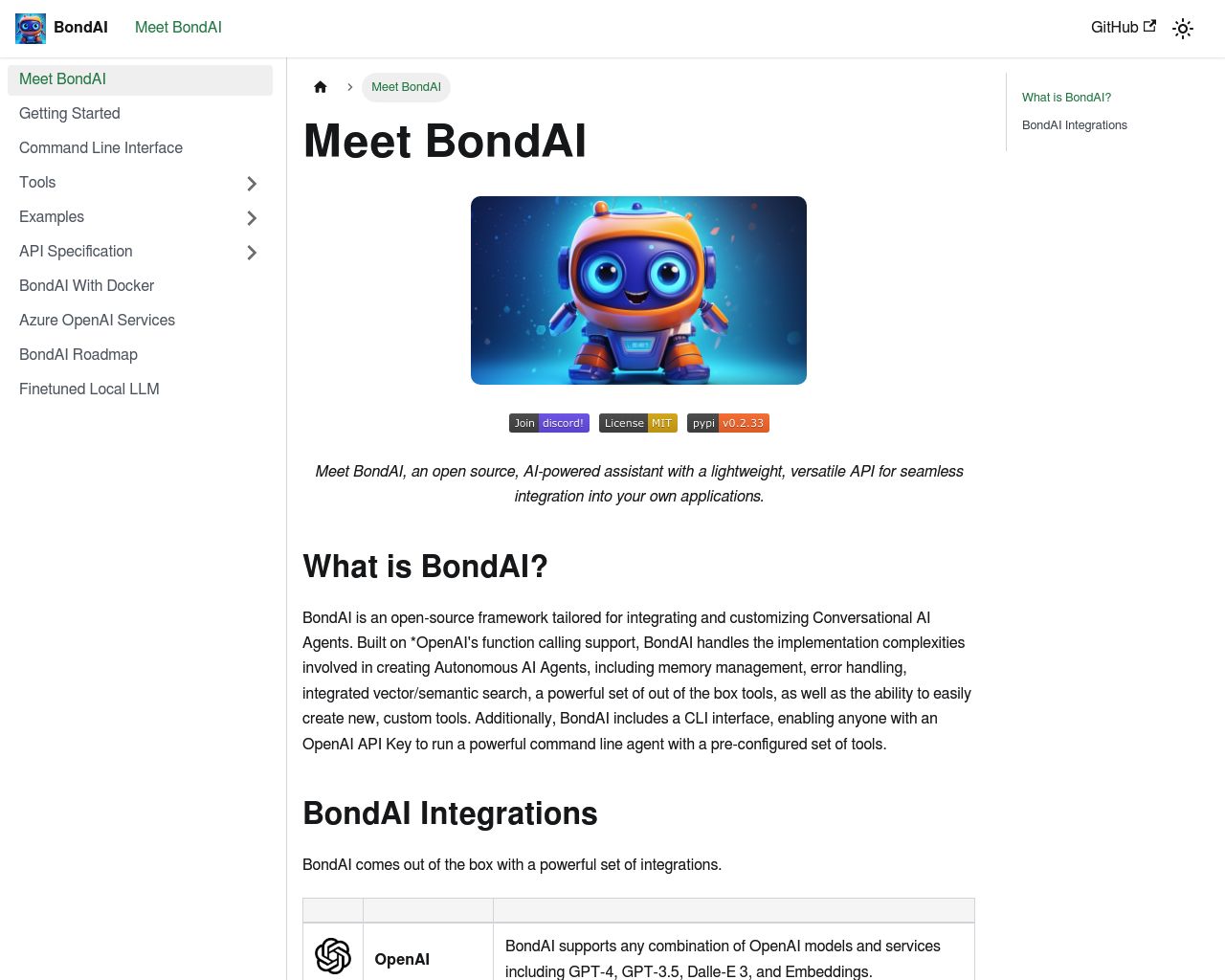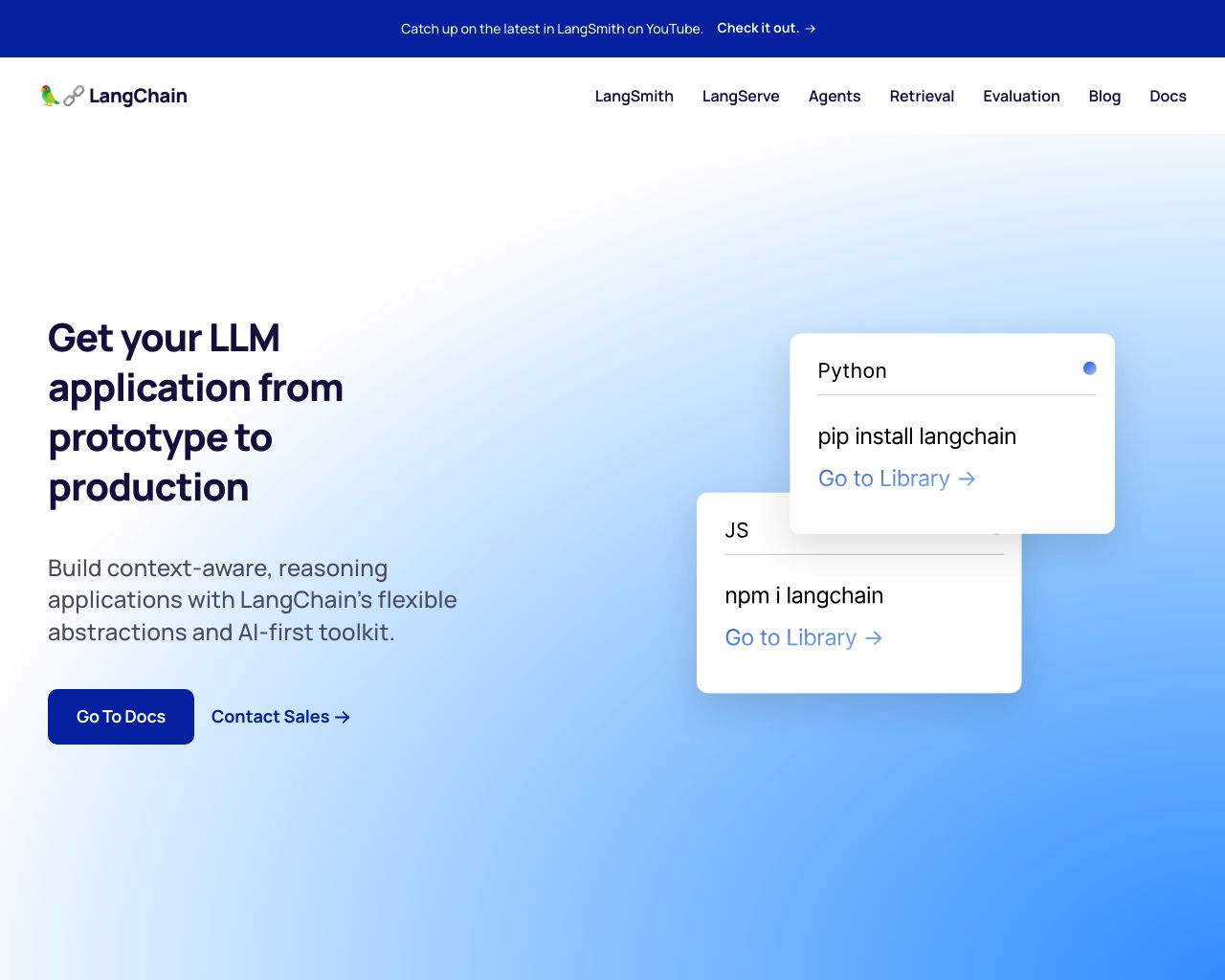BondAI And LangChain: A Detailed Comparison
AI agent development platforms transform how businesses leverage artificial intelligence, offering powerful tools to create sophisticated applications. This comparison explores BondAI and LangChain, two leading frameworks in the AI development space, alongside SmythOS, our innovative solution. We examine each platform’s unique features, strengths, and limitations to help you choose the best tool for your AI development needs. From memory management and integration capabilities to user-friendliness and deployment options, this review covers crucial aspects that set these platforms apart. Whether you’re a seasoned developer or a business leader exploring AI solutions, our analysis provides valuable insights to guide your decision-making process.
BondAI Overview
BondAI empowers developers to create, host, and manage sophisticated AI agents. This open-source framework simplifies complex AI agent development tasks, including memory management, error handling, and semantic search. BondAI integrates seamlessly with popular AI services and tools, offering a versatile set of features right out of the box.
The platform supports advanced AI architectures like ReAct Agents and ConversationalAgents, enabling both individual interactions and multi-agent systems. These capabilities allow BondAI-powered agents to tackle complex tasks that surpass single-agent models. BondAI’s extensive integration with services such as OpenAI, Azure, Google Search, and LangChain expands its utility across various applications, from research and trading to home automation and customer support.
BondAI empowers developers to create, host, and manage sophisticated AI agents. This open-source framework simplifies complex AI agent development tasks, including memory management, error handling, and semantic search.
BondAI stands out with its robust memory management system, inspired by the MemGPT paper. This tiered approach efficiently handles extensive contexts and complex conversations, using core memory for immediate tasks, conversation memory for dialogue history, and archival memory for long-term data storage. This structure enhances the agents’ problem-solving capabilities by efficiently managing and retrieving information.


BondAI offers flexibility in deployment, allowing users to leverage the framework via a Command Line Interface (CLI), Docker containers, or direct integration into codebases for custom agent development. This versatility enables quick starts with pre-configured tools or the building and integration of custom tools into the framework.
BondAI offers flexibility in deployment, allowing users to leverage the framework via a Command Line Interface (CLI), Docker containers, or direct integration into codebases for custom agent development.
While BondAI excels in many areas, it lacks some features found in other platforms. The absence of a visual builder or no-code editor may limit accessibility for non-technical users. Additionally, there’s no mention of specific features for bulk work operations or an agent work scheduler, which could be drawbacks for users requiring these functionalities.
Despite these limitations, BondAI’s combination of advanced AI research, extensive tool integration, and flexible implementation options makes it a compelling choice for developers and researchers aiming to build powerful AI-driven applications. Its open-source nature also encourages community contributions and continuous improvement, potentially addressing current limitations in future updates.
LangChain Overview
LangChain revolutionizes AI application development by providing a comprehensive open-source framework for building language model-powered applications. The platform simplifies the creation of sophisticated AI agents capable of reasoning, planning, and executing complex tasks.
At its core, LangChain offers a modular architecture that empowers developers to construct AI applications with ease. The framework includes essential components such as prompt templates, memory systems, and chains that streamline the development process. These building blocks enable the creation of conversational agents, autonomous task executors, and question-answering systems tailored to specific use cases.
LangChain revolutionizes AI application development by providing a comprehensive open-source framework for building language model-powered applications.
LangChain excels in its integration capabilities, supporting a wide array of APIs and tools. This flexibility allows developers to leverage external knowledge bases, vector stores, and specialized APIs to enhance their AI agents’ functionality. The platform’s support for stateful applications through LangGraph further expands its utility, enabling the creation of multi-step, context-aware AI workflows.


Despite its power, LangChain poses a steeper learning curve for non-technical users. The platform primarily caters to developers and data scientists comfortable with Python programming. While it offers extensive documentation and examples, users without coding experience may find it challenging to fully utilize LangChain’s capabilities.
LangChain poses a steeper learning curve for non-technical users… users without coding experience may find it challenging to fully utilize LangChain’s capabilities.
LangChain’s ecosystem includes complementary tools like LangSmith for debugging and monitoring, and LangServe for deploying applications as APIs. These additions enhance the platform’s appeal for production environments, offering robust solutions for testing, optimization, and deployment. However, the lack of a unified, user-friendly interface for these tools may present obstacles for teams seeking an all-in-one solution.
Feature Comparison
BondAI and LangChain offer distinct approaches to AI agent development, each with unique strengths and limitations. BondAI excels in memory management, featuring a sophisticated system inspired by the MemGPT paper. This tiered approach efficiently handles extensive contexts and complex conversations, using core memory for immediate tasks, conversation memory for dialogue history, and archival memory for long-term data storage. LangChain, while lacking this specific memory architecture, provides a more flexible framework for building custom memory systems tailored to specific use cases.
In terms of core components, LangChain offers a more extensive set of pre-built tools and integrations. Its modular architecture allows developers to easily combine various components like prompt templates, memory systems, and chains to create sophisticated AI applications. BondAI, while offering strong integration capabilities, doesn’t match LangChain’s breadth of pre-built components.
Security features present another area of divergence. BondAI leverages Azure OpenAI Services for deployment, implying robust security measures and data encryption capabilities. LangChain, being primarily a development framework, leaves security implementation largely to the developer, potentially requiring more effort to ensure comprehensive data protection and access control. We provide built-in security features, including data encryption and OAuth integration, making it easier for developers to create secure AI applications out of the box.
Feature Comparison Table
| BondAI | LangChain | SmythOS | |
|---|---|---|---|
| CORE FEATURES | |||
| Visual Builder | ❌ | ❌ | ✅ |
| No-Code Options | ❌ | ❌ | ✅ |
| Audit Logs for Analytics | ❌ | ✅ | ✅ |
| Agent Work Scheduler | ✅ | ❌ | ✅ |
| SECURITY | |||
| Constrained Alignment | ❌ | ❌ | ✅ |
| IP Control | ❌ | ❌ | ✅ |
| COMPONENTS | |||
| Zapier APIs | ✅ | ❌ | ✅ |
| Data Lakes | ❌ | ❌ | ✅ |
| DEPLOYMENT OPTIONS (EMBODIMENTS) | |||
| Deploy as Webhook | ✅ | ❌ | ✅ |
| Staging Domains | ❌ | ❌ | ✅ |
| Production Domains | ✅ | ❌ | ✅ |
| Deploy as Scheduled Agent | ❌ | ❌ | ✅ |
| DATA LAKE SUPPORT | |||
| Hosted Vector Database | ❌ | ❌ | ✅ |
| Sitemap Crawler | ❌ | ❌ | ✅ |
| YouTube Transcript Crawler | ❌ | ❌ | ✅ |
| URL Crawler | ✅ | ❌ | ✅ |
| Word File Support | ✅ | ❌ | ✅ |
Best Alternative to BondAI and LangChain
SmythOS stands out as the superior alternative to BondAI and LangChain for AI agent development and deployment. Our platform combines advanced capabilities with unparalleled ease of use, making it the ideal choice for businesses and developers seeking to harness the power of AI. SmythOS offers a visual drag-and-drop interface that simplifies the creation of complex AI workflows, eliminating the need for extensive coding knowledge. This intuitive approach democratizes AI development, allowing users of all skill levels to build sophisticated agents quickly and efficiently. Unlike BondAI and LangChain, which require more technical expertise, SmythOS empowers users to focus on innovation rather than implementation details.
SmythOS offers a visual drag-and-drop interface that simplifies the creation of complex AI workflows, eliminating the need for extensive coding knowledge.
We provide a comprehensive suite of pre-built API integrations and templates, significantly reducing setup time and accelerating the development process. Our platform supports a wide array of AI models from various providers, ensuring flexibility and compatibility with existing systems. SmythOS excels in scalability and deployment options, offering seamless integration across multiple environments and platforms.
Whether you need to deploy agents as APIs, webhooks, or chatbots, our system provides the versatility to meet diverse business requirements. Security is a top priority, with built-in features like data encryption and OAuth integration, addressing concerns that may require additional effort with other platforms. The SmythOS Agent Work Scheduler and real-time monitoring capabilities offer unparalleled control and oversight, allowing for efficient management of AI workflows.
By choosing SmythOS, users gain access to a robust ecosystem that supports multi-agent collaboration, advanced problem-solving capabilities, and seamless human-AI interactions. Our platform’s ability to handle various data types, including PDFs, Word documents, and web content, further enhances its utility across different industries and use cases. In essence, SmythOS combines the best features of AI agent development platforms while eliminating common limitations, making it the most comprehensive and user-friendly solution available.
Conclusion
BondAI and LangChain offer powerful frameworks for AI agent development, each with distinct strengths. BondAI excels in memory management and supports advanced AI architectures, while LangChain provides a more extensive set of pre-built components and integrations. Both platforms cater primarily to developers and researchers, potentially limiting their accessibility to non-technical users.
SmythOS stands out as the superior choice, combining the strengths of both platforms while addressing their limitations. Our intuitive drag-and-drop interface paired with pre-built API integrations makes AI development accessible to a broader audience. We support multi-agent systems, offer versatile deployment options, and provide robust security features out of the box.
Unlike BondAI and LangChain, SmythOS empowers users to create and deploy AI agents across various platforms seamlessly. Our “Create Once, Deploy Anywhere” approach allows for effortless integration into multiple environments, from chatbots to APIs. This versatility, combined with our extensive integration ecosystem of over 300,000 connections, positions SmythOS as the ideal solution for businesses looking to harness the full potential of AI.
Experience the future of AI development with SmythOS. Create a free account today and start building powerful AI agents without code. Explore our diverse range of AI-powered agent templates to jumpstart your projects, or dive into our comprehensive documentation to unlock the full capabilities of our platform. With SmythOS, you’re not just keeping pace with AI innovation — you’re leading it.
Last updated:
Disclaimer: The information presented in this article is for general informational purposes only and is provided as is. While we strive to keep the content up-to-date and accurate, we make no representations or warranties of any kind, express or implied, about the completeness, accuracy, reliability, suitability, or availability of the information contained in this article.
Any reliance you place on such information is strictly at your own risk. We reserve the right to make additions, deletions, or modifications to the contents of this article at any time without prior notice.
In no event will we be liable for any loss or damage including without limitation, indirect or consequential loss or damage, or any loss or damage whatsoever arising from loss of data, profits, or any other loss not specified herein arising out of, or in connection with, the use of this article.
Despite our best efforts, this article may contain oversights, errors, or omissions. If you notice any inaccuracies or have concerns about the content, please report them through our content feedback form. Your input helps us maintain the quality and reliability of our information.
